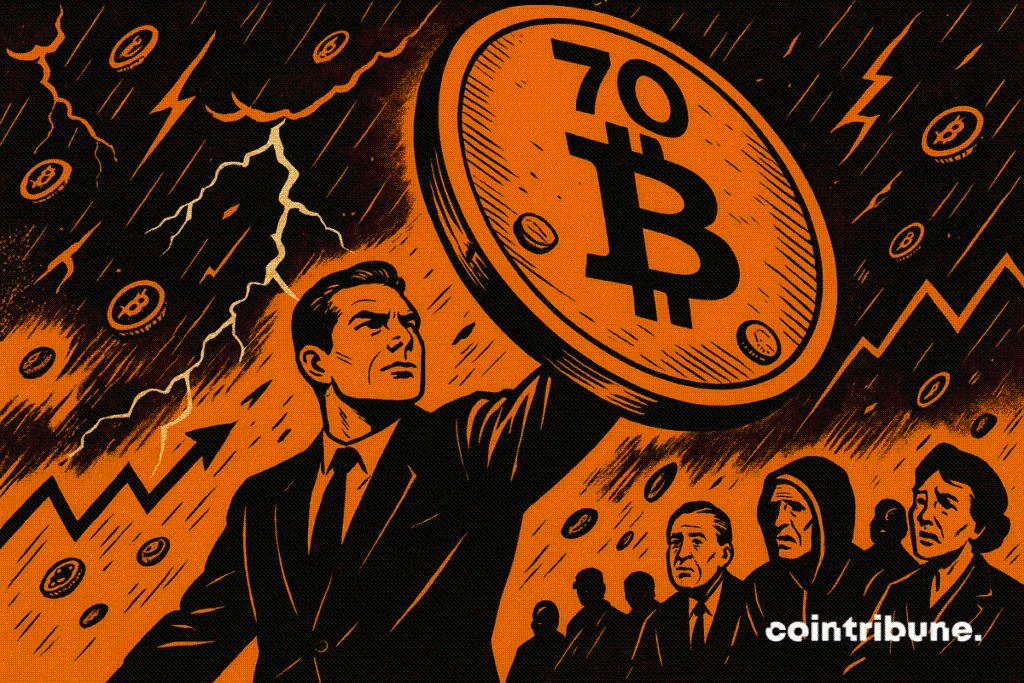Strategy unveils a new anti-panic weapon against the bitcoin crisis
Since the fall of bitcoin, Strategy’s strategy worries more than one. Faced with this, the company has just unveiled a new tool. A move to reassure crypto investors and maintain its role as an institutional pillar. More details in the following paragraphs!

In brief
- Strategy launches a BTC Rating to reassure markets after the marked bitcoin drop.
- The company claims 70 years of financial margin, even if the bitcoin price remains stagnant.
Strategy counter-attacks with a BTC Rating
The BTC Rating is an indicator expressly designed by Strategy. It is supposed to reflect the company’s debt strength following the recent market turbulence on bitcoin.
More explicitly, the BTC Rating relies on the notional value of preferred shares. It shows that even if bitcoin falls to $74,000 (its average purchase price), Strategy retains an asset/debt ratio of 5.9. If the price collapses to $25,000, the ratio will remain at 2.
In both cases, the liquidity would allow dividends to be paid for 70 years. A projection that some consider ambitious but credible in a flat market scenario.
This communication aims to dispel the fear of a domino effect on the stocks of companies related to digital assets, often called DAT (Digital Asset Treasuries). The BTC Credit Dashboard published by Strategy centralizes these key data.
Debt, dividends and mNAV: the new equation of bitcoin strategy’s strength
Alongside this BTC Rating , another indicator attracts attention: the mNAV (Market Net Asset Value). This index compares the enterprise value to that of crypto holdings (notably bitcoin).
With a score of 1.16, Strategy can theoretically still raise funds by issuing shares. A capacity no longer available to some struggling players like Bitmine and Sharplink Gaming.
Some analysts confirm this strength. According to them, the dividend strategy holds up long-term (unless there is a sudden regulatory change). For others, Strategy’s continuous accumulation of bitcoin could slow future drops by absorbing part of the supply. These reserves, considered “off-market,” thus block an additional selling pressure.
While the crypto market remains volatile, the signals sent by Strategy thus reinforce its position as an institutional bastion for bitcoin. The company becomes a reference to follow in the assessment of crypto risks.
Disclaimer: The content of this article solely reflects the author's opinion and does not represent the platform in any capacity. This article is not intended to serve as a reference for making investment decisions.
You may also like
The Psychological Factors Influencing Retail Investors’ Actions in Cryptocurrency Markets
- Crypto markets are shaped by behavioral finance, where retail investors drive volatility through FOMO, herd behavior, and overconfidence. - The PENGU token exemplifies this dynamic, surging 480% in July 2025 but plummeting 28.5% by October due to emotional trading cycles. - Social media amplifies emotional contagion, with traders checking prices 14.5 times daily, while financial literacy mitigates bias susceptibility. - Personality traits like neuroticism increase cognitive biases, and speculative narrat

Bitcoin News Today: Bitcoin's Unstable Holiday Periods Hide Average Gains of 6%
- Bitcoin's Thanksgiving-to-Christmas performance shows equal odds of rising or falling, with a 6% average seasonal return despite volatility. - Historical extremes include a 50% 2020 rally and 2022's 3.62% drop post-FTX collapse, amid a $2.49-to-$91,600 long-term surge since 2011. - 2025's $91,600 price reflects ongoing recovery from 2024's $95,531 peak, with institutional crypto adoption and macroeconomic factors shaping future trajectories. - Analysts advise dollar-cost averaging for retail investors, w

Australia Strikes a Balance Between Fostering Crypto Innovation and Safeguarding Investors with Updated Regulations
- Australia introduces 2025 Digital Assets Framework Bill to regulate crypto platforms under ASIC, creating "digital asset platform" and "tokenized custody platform" licenses. - The framework mandates custody standards, transparency requirements, and lighter regulations for small operators (<$5k per customer) to balance innovation with investor protection. - Global alignment with UAE and EU crypto regulations is emphasized, while addressing risks from past failures like FTX through stricter enforcement and

PENGU Token's Latest Price Fluctuations and Blockchain Indicators: An Analytical Perspective on Technical Factors and Institutional Activity
- PENGU token's recent volatility and on-chain activity spark debate over institutional involvement in the crypto market. - Technical indicators show conflicting signals: overbought RSI vs. positive MACD/OBV momentum since November 2025. - Whale accumulation and Solana integration suggest strategic buying, while team wallet outflows highlight market uncertainty. - Social media sentiment drives short-term price swings, but structural risks like tokenomics and regulatory ambiguity persist. - Institutional ad

